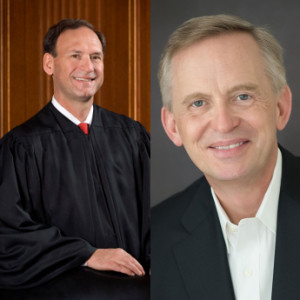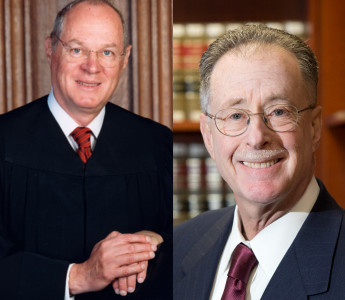Ocasio v. United States, 578 U.S. ___ (2016) (Alito, J.).
Response by Professor Randall D. Eliason
Geo. Wash. L. Rev. On the Docket (Oct. Term 2015)
Slip Opinion | New York Times | SCOTUSblog
The Contortionist Extortionist
In criminal law, we ordinarily think of perpetrator and victim as two distinct entities. It would be nonsensical, for example, to talk about me robbing myself or defrauding myself. But last week in Ocasio v. United States1 the Supreme Court ruled 5-3 that a defendant may be charged with conspiring to extort money from himself.
Although it sounds a bit bizarre, this result doesn’t represent some new watershed in white collar crime or dramatic expansion of federal criminal jurisdiction. It’s simply the logical and unfortunate outgrowth of a questionable Supreme Court decision more than two decades old.
Samuel Ocasio was one of a number of Baltimore police officers involved in a widespread corruption scheme with the owners of a garage called Majestic Auto Repair. Police officers would refer drivers involved in car accidents to Majestic for necessary repairs, and in return the garage owners would pay the officers $150 to $300 per car. When the scheme came to light Ocasio, a number of other officers, and the owners of Majestic were charged with conspiracy to commit extortion under the Hobbs Act.2
Extortion usually connotes payments made under some kind of duress; a burly guy smacking his palm with a baseball bat while he recommends that you buy the “health insurance” he is selling. But the Hobbs Act also prohibits extortion “under color of official right,” which essentially operates as bribery by another name. And because the federal bribery statute generally applies only to federal officials, prosecutors frequently turn to Hobbs Act extortion to prosecute state and local bribery schemes such as that in Ocasio.
The use of Hobbs Act extortion to prosecute bribery has its roots in a 1992 Supreme Court case, Evans v. United States.3 Evans, a county commissioner in Georgia, was convicted of extortion under color of official right for accepting money in exchange for a favorable zoning decision. The Court rejected Evans’ claim that he had to actually induce the payment or “shake down” the payer to be guilty of extortion. It held that at common law extortion under color of official right was the “rough equivalent of what we would now describe as ‘taking a bribe.’”4 It was enough that a public official accepted a payment knowing that it was given in exchange for some exercise of official power.
Justice Thomas wrote a vigorous dissent in Evans. He argued that bribery and extortion had always been distinct crimes and that the majority’s decision obliterated that distinction. In particular, in a bribery case both sides—the bribe payer and the bribe recipient—are guilty parties to a corrupt deal, and both may be prosecuted. But in extortion, the person who pays the official is considered a victim, not a willing and culpable participant.
Extortion under color of official right applies only to public officials; on its face the Hobbs Act does not prohibit the payment of the extortion. What Evans left behind, therefore, was an oddity probably unique in criminal law: a statute that prohibits bribery but only punishes the public official side of the bribe transaction. More than twenty years later, the implications of that decision led to the dispute that landed before the Supreme Court in Ocasio.
Once Evans declared extortion under color of official right to be equivalent to bribery, it was predictable that prosecutors in appropriate cases would seek a way to charge the payer’s side of those bribery transactions. Some cases have charged bribe payers with aiding and abetting their own extortion by the officials they were paying. An equally inelegant theory is that used in Ocasio: prosecutors indicted the garage owners and Officer Ocasio for conspiracy to violate the Hobbs Act, charging that the owners conspired with Ocasio to extort money from the owners themselves.
Ocasio’s case before the Court challenged this conspiracy theory and hinged on the language of the Hobbs Act. The statute’s definition of extortion requires that the public official obtain property of “another.” In the context of a conspiracy, Ocasio claimed, this must mean the conspirators agree to obtain property from someone outside of that conspiracy. If the co-conspirators simply agree to exchange property among themselves, he argued, they do not obtain property of “another” within the meaning of the statute.
The majority, through Justice Alito, rejected this argument. Ocasio’s conviction, the Court said, was simply a straightforward application of textbook conspiracy law: someone can be guilty of conspiracy to commit a crime even if they didn’t or couldn’t commit all elements of the underlying crime themselves.
For example, if I act as an agent for a Congressman to solicit bribes from defense contractors, I can be found guilty of conspiracy to accept bribes even though, as someone who is not a public official, I could not be charged with accepting bribes myself. If I participate in a bank robbery by providing the robbers with inside information about the bank vault and security, I’ve conspired to commit bank robbery even if I never take part in the actual robbery itself.
In Ocasio’s case, the Court held, it’s true the garage owners, as private citizens, could not commit the crime of extortion under color of official right—but they could conspire to help officer Ocasio commit it. Ocasio violated the statute by obtaining property of “another,” which simply means someone other than Officer Ocasio. In this case, the “another” was the garage owners themselves, who also happened to be Ocasio’s co-conspirators.
The Court rejected concerns that this holding might make even innocent extortion victims liable for conspiring with those they paid. There is a distinction, the Court noted, between grudging consent given by a payer who feels he has no alternative and the proof of intent required to establish that the payer knowingly and voluntarily joined a conspiracy. Only the latter is the equivalent of bribery that would render the payer equally as culpable as the public official.
Justice Breyer wrote a brief concurrence, saying that the convoluted result made him tend to agree with Justice Thomas that Evans was probably wrongly decided. Nevertheless, he concluded, Ocasio had not asked the Court to overrule Evans, and given that case’s holding the majority opinion was correct as a matter of conspiracy law.
Justice Thomas, not surprisingly, dissented and reiterated his view that Evans was a mistake. He argued the Court should not compound the error by extending the reasoning of Evans to encompass Hobbs Act conspiracy. Justice Sotomayor, joined by Chief Justice Roberts, wrote a separate dissent agreeing with Officer Ocasio that the most natural reading of the statutory language required the members of the conspiracy to obtain the property of someone outside the conspiracy.
I think Justice Breyer has it right; if we start with the Evans holding as a given, then Ocasio seems correct. The linguistic gymnastics required to frame a charge against the bribe payers in what is really a bribery case do highlight the shaky foundation of the Evans holding. But as the majority noted, if you accept Evans, then basic conspiracy law dictates the result in Ocasio.
The dissenters expressed concerns about the breadth of federal criminal statutes and the scope of conspiracy law. Justice Sotomayor said she feared the Court’s ruling would invite prosecutors to round up all parties in an extortion scheme, charge everyone with conspiracy, and see “what sticks and who flips.”5 They also raised federalism concerns, questioning whether it was appropriate for the federal government to pursue local corruption cases that could be left to the states.
Debates about sweeping federal criminal statutes and the dangers of prosecutorial power are common these days. The pending case involving the corruption convictions of former Virginia Governor Bob McDonnell6 (also a Hobbs Act case) contains many of the same themes. But in Ocasio, concerns about inappropriate charges have little force. No one suggests the owners of Majestic were not blameworthy or did not deserve to be prosecuted.
As for federalism concerns, there are already many ways for federal prosecutors to charge state and local bribery. Even before the Court’s decision in Skilling v. United States,7 for example, it’s been clear that honest services mail and wire fraud8 applies to bribery and kickback schemes like that in Ocasio. Under certain conditions the Travel Act9 and the Federal Program Bribery10 statute also apply to state and local corruption. It’s even likely that prosecutors could have named Majestic as a RICO enterprise and indicted everyone involved for violating RICO based on a pattern of state-law bribery.11
In short, there are plenty of ways for federal prosecutors to pursue state and local corruption. The Hobbs Act is just one potential arrow in the prosecutor’s quiver. If Ocasio had gone the other way, I doubt there’s a single future case that would have gone unprosecuted as a result. If the Court really has issues with federal prosecutors having the power to charge state and local bribery, that ship sailed long ago.
The concern about prosecutors having the power to pick and choose whom to charge with conspiracy is similarly misplaced. Prosecutors do this all the time when deciding whether a particular scheme is a true extortion scheme, where the payers are the victims, or is more like a traditional bribery scheme where the payers should be charged. That’s the essence of prosecutorial discretion and making sound charging decisions.
It’s a little disheartening to hear Justice Sotomayor, herself a former prosecutor, suggest that prosecutors might just round up everyone they see and charge them with conspiracy with no regard for actual culpability. If that actually happens it’s a much bigger problem than the breadth of the Hobbs Act—but the presence or absence of one legal theory would not make any practical difference.
In the end, therefore, Ocasio leaves the white collar crime landscape largely unchanged. Future defendants, seeing a potential invitation in Ocasio, will likely file petitions asking the Court to overturn Evans, but it’s tough to see a current majority willing to do that. Congress, of course, could step in and clear everything up by amending the Hobbs Act, but that seems even less likely. We appear destined simply to soldier on with the untidy legacy of Evans and its peculiar version of extortion distortion.
In addition to being a Professorial Lecturer in Law at the George Washington Law School, Randall D. Eliason specialized in white collar crime for over eight years as a member of the Public Corruption/Government Fraud section of the Office of the United States Attorney for the District of Columbia. From 1999 to 2001, he served as chief of that section, supervising a staff of eleven AUSA’s prosecuting white collar cases in federal court. Mr. Eliason is the recipient of numerous awards and commendations from the U.S. Department of Justice, Federal Bureau of Investigation, Washington D.C. Metropolitan Police Department, and other law enforcement agencies.
Randall D. Eliason is also a frequent media commentator on issues related to corporate and white collar crime and has appeared on PBS’s Frontline, NBC’s Nightly News, NPR’s Morning Edition, CNN, MSNBC, and elsewhere. His writings on federal criminal law have been published in law reviews, legal periodicals, and newspapers including The Washington Post and the Chicago Tribune. He writes about white collar crime and federal criminal law at Sidebars Blog, where he has previously discussed Ocasio v. United States.
-
- Ocasio v. United States, No. 14-361, slip op. (U.S. May 2, 2016).
- Hobbs Act, 18 U.S.C. § 1951 (2012).
- Evans v. United States, 504 U.S. 255 (1992).
- Id. at 260.
- Ocasio, slip op. at 11 (Sotomayor, J., dissenting).
- McDonnell v. United States, 136 S. Ct. 891 (2016) (argued April 27, 2016).
- Skilling v. United States, 561 U.S. 358 (2010).
- Mail fraud, 18 U.S.C. § 1341 (2012), and wire fraud, 18 U.S.C. §1343 (2012), both criminalize schemes to defraud that include schemes to “deprive another of the intangible right of honest services.” 18 U.S.C. § 1346 (2012). Although the exact scope of this theory was unclear for decades, Skilling held that honest services fraud was limited to cases involving bribery and kickbacks.
- Travel Act, 18 U.S.C. § 1952 (2012).
- 18 U.S.C. § 666 (2012).
- See 18 U.S.C. § 1962 (2012).
Recommended Citation:
Randall Eliason, Response, Ocasio v. United States: The Contortionist Extortionist , Geo. Wash. L. Rev. On the Docket (May 10, 2016), http://www.gwlr.org/ocasio-v-united-states-the-contortionist-extortionist/.





